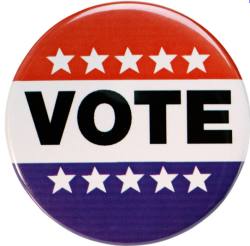Get Out the Vote for Your Neighbors Running for the Citizens Nominating Committee on November 12, 2019
- Details
- Written by: Joanne Wallenstein
- Hits: 3877
 On Tuesday, November 12, a week after the November 5 general elections, Scarsdale voters will turn out again to elect their neighbors who are running for seats on the nonpartisan Citizens Nominating Committee (CNC). Sixteen residents have volunteered to run for open spots on the CNC as representatives from each elementary school district. Those who are elected will join current CNC members to meet and evaluate non-partisan candidates for the village offices of three Trustees and Village Justice. The 30 elected members of the CNC will then nominate candidates to represent the Non-Partisan party’s slate in the village election, which takes place on Tuesday, March 17, 2020.*
On Tuesday, November 12, a week after the November 5 general elections, Scarsdale voters will turn out again to elect their neighbors who are running for seats on the nonpartisan Citizens Nominating Committee (CNC). Sixteen residents have volunteered to run for open spots on the CNC as representatives from each elementary school district. Those who are elected will join current CNC members to meet and evaluate non-partisan candidates for the village offices of three Trustees and Village Justice. The 30 elected members of the CNC will then nominate candidates to represent the Non-Partisan party’s slate in the village election, which takes place on Tuesday, March 17, 2020.*
The Procedure Committee, comprised of CNC graduates and other Scarsdale volunteers, administers the CNC process. According to Procedure Committee Chair Eric Cheng, “these are the candidates whose names will appear on the CNC ballot on November 12, and the current members of the CNC. Biographies of each candidate will appear in the Election Brochure mailed to all residents, who are encouraged to look for it in their mailbox the week prior to November 12.

Procedure Committee Co-Chair Sarit Kessel Fuchs stated that “Voters this year will elect two candidates from each Election Unit neighborhood with the exception of Quaker Ridge, where voters will elect three candidates, and the third highest vote getter in this election will fill a one-year vacancy. The new nominating committee members elected on November 12 will join 19 other residents now serving staggered three-year terms on the CNC.”
This year the Procedure Committee has proposed no amendments to the Non-Partisan Resolution, the governing document of the non-partisan electoral system.
ALL DAY VOTING: The CNC election will be held on Tuesday, November 12, 2019 at Village Hall. Residents who are qualified voters may vote in person in the Village Hall Lobby on that date from 7:00 AM to 9:00 PM, or by mail-in ballot. Mail-in ballots must be received in the Procedure Committee’s Chase Road P.O. Box 284 by 5:00 PM on Election Day. In the event of a tie, a run-off election will be held on Tuesday, November 19, 2018.
The members of the 2019-2020 Procedure Committee are: Stephen Baer, Daniel Brown, Eric Cheng, Chair, Marie DiPalma, Madelaine Eppenstein, Sarit Kessel Fuchs, Vice Chair, Dan Gerardi, Judy Wenjing Kerr, Jon Leslie, Matt Martin, Barry Meiselman, BK Munguia, ML Perlman, Andrew Sereysky, Gregory Soldatenko, Peter Tesler, Amber Yusef, and Anne Zink. Contact: Eric Cheng, Chair, chengchoi@optonline.net; Sarit Kessel Fuchs, Vice Chair, kessel7@hotmail.com
* Under New York State Law, candidates may run outside the non-partisan election system for village office through a write in campaign or by obtaining the prescribed number of signatures on a nominating petition.
Village Attorney to be Replaced with Outside Counsel, Trustees Express Support for Reducing Speed Limit to 25 mph, Climate Change and more...
- Details
- Written by: Joanne Wallenstein
- Hits: 5243
 Mayor Marc Samwick announced that Village Attorney Angela Sapienza-Martin would return to her previous position as Director of Personnel and Risk Management and the position of Village Attorney would be eliminated at the October 7 meeting of the Scarsdale Village Board.
Mayor Marc Samwick announced that Village Attorney Angela Sapienza-Martin would return to her previous position as Director of Personnel and Risk Management and the position of Village Attorney would be eliminated at the October 7 meeting of the Scarsdale Village Board.
Spienza-Martin was appointed to the position of Village Attorney in June 2018 after long-time attorney Wayne Esannason retired. However, Samwick explained that Adil Tahir, who took over as Director of Personnel, would be leaving, and Sapienza would return to her former position. Rather than fill the position of Village Attorney, the Village will retain a law firm to handle the Village’s legal matters. He said that the Village’s “needs are broad, requiring expertise in a wide array of practice areas,” and that a firm could offer these services at a reduced cost. A search committee has been formed to interview prospective firms. In the interim, former Village Attorney Wayne Esannason will return as Village Attorney, effective October 21.
Fall Leaf Collection
Samwick announced that leaf collection would begin on October 15 and said the schedule is available on the Village website. He reminded residents to pile leaves on their lawns, not in the streets and warned against blocking storm drains, hydrants and corners. He said that residents, not their landscapers were responsible for violations. He also asked residents to consider mulching in place rather than raking leaves for collection. Mulch mowing is more efficient, reduces the need for watering, improves lawns and enhances the soil.
Streetlights
Ron Schulhof provided an update on the conversion of Village streetlights to LED light, reporting that 1,500 lights were converted by the Village’s highway department during the summer. This phase, along with the first phase of conversion to LED lights on high traffic roads will yield the Village a savings of $100,000 per year and will also save energy. As of now, about 93% of the lights have been converted. The committee is looking for LED alternatives for decorative lights in the Village.
Climate Change
Tim Foley and several residents spoke about measures the Village could take to address climate change. Foley is co-chair of the Scarsdale Forum’s Climate Resilience Committee who is exploring how Scarsdale can address the challenges of climate change. They plan to do a study of climate action plans from comparable communities and explore sources of funding.
As a preliminary step, the committee is recommending that Scarsdale join the NYS Climate Smart Communities Program by passing a municipal resolution to take 10 pledges to adapt to mitigate global warming. He said, “Joining 34 Westchester communities would qualify Scarsdale to receive technical support, rebates and matching funds from the state to adapt to climate resilience projects.”
The committee also recommends that Scarsdale declare a Sustainability Day on a Sunday in May 2020 to celebrate the Village’s accomplishments to make Scarsdale a more sustainable community, to educate the community and to call for every community to do their part to mitigate the effects of climate change.
He concluded by saying, “The time to start planning and taking action was yesterday.”
Former Trustee Kay Eisenman from Brewster Road echoed Foley’s remarks. She is a member of the committee and hopes that the Board will sign onto to the resilience pact. She said, “I don’t see any downside in us doing this.”
Darlene Francois-Haber from Nelson Road, also on the committee, said she looked at the 100 items on the climate smart community checklist for the program. She said, “We already have 100 points toward certification. This is a win-win. There is nothing to lose and everything to gain. We are talking about gaining matching funds for our municipality. I urge you to take the pledge and establish a sustainability day.”
Former Village Trustee Bill Stern spoke in favor of leaf mulching and the climate change resolution. He said, “We have to be more aggressive than just using education.” About Foley’s proposal he said, “we need to support these two measures… It’s extraordinarily important to keep Scarsdale for future generations. There is always push back but the government should act for the greater good.”
Jordan Copeland from Woods Lane spoke in favor of the climate change resolution. He said, “Scarsdale is a leader in every way and we should stand up for what is right for the future and the kids.”
Speed Limit
Apparently the speed limit on local streets is dictated by the New York State law. Current law mandates a speed limit of not less than 30 miles per hour, even in areas with busy pedestrian activity like the Village Center. Research has found that pedestrian accidents and fatalities are significantly reduced when the speed limit is reduced from 30 mph to 25 mph. However, the Village has no power to reduce the limit under current NYS law. NYS Assemblywoman Amy Paulin has introduced two bills to allow municipalities to reduce the speed limit to 25 mph and the Scarsdale Board of Trustees passed a resolution in favor of this new legislation.
The Board voted unanimously to support the resolution. They agreed that reducing the speed limit would improve safety and all found it frustrating that this was not under the jurisdiction of the local government.
However, Mayor Samwick noted that the matter is up to the Village’s Traffic Safety Committee, which is comprised of engineers, law enforcement and members of the Village Manager’s office. He said, “We should recognize the process. Our view is clear. We are the policy body – but this is not our decision to make.”
Madelaine Eppenstein spoke in favor of the resolution. Jordan Copeland asked the Village to also consider using other tactics such as pavement lines and obstacles to slow the flow of traffic. He said, “About the reduction of the speed limit to 25 mph, I am in favor of safer streets. Enforcement, education and engineering can all be used to improve traffic safety. I urge you to be creative with engineering solutions. In Sweden they are shrinking their lanes. There is more you can do with paint. Increase the cognitive load on people. Think about using striping to get people to slow down. Take the focus away from enforcement and figure out how you can make them slow down.”
Freightway RFP Process
Both Robert Berg and Michael Levine spoke about the RFP process for the proposed development at the Freightway site.
Berg opined about a lack of transparency. He called the project “a train wreck waiting to happen.” He said, “It is the largest development project since the downtown was first built. It should proceed only if it makes sense to the existing property owners. It must reduce the taxes of single-family homeowners or else it does not make sense to the do the project. It is almost guaranteed that it will require homeowners to pay more taxes to subsidize the homeowners who live there.”
He objected to the bidding process which he said protected the six original bidders. He said, “The result is that five of the six submitted the bids, two joined forces, reducing the total bids to four. Only three bids were submitted. Now the board will select two finalists.” He claimed that this prevented residents from getting the full benefit of competitive bids. He asked that the bidding be re-opened.
He continued, “You have released no information about the bids that were submitted three weeks ago and shared nothing about the type of housing each bidder proposed. If it is for rental housing the project fails from the outset because rentals receive more favorable tax treatment than single family homes under NYS real property tax laws. Rentals typically pay 1/3 of the taxes of single-family homes under the law. If rentals are constructed, nearly all homeowners will be subsidizing those rentals. They should pay the same rate of taxes. We don’t need to build Freightway to increase our own taxes.”
Berg also objected to another $40,000 that had been allocated to the Freightway planning consultants.
Responding to Berg, Mayor Samwick said that the Board of Trustees had requested a change in scope and that was why there was an increase in the fee to the planning consultants. About the real estate taxes, Samwick said that was a NYS law. He said, “What are the costs of doing nothing.” This would definitely be a burden on Scarsdale taxpayers.
About transparency, Samwick explained that some confidentiality was necessary to protect the Village’s negotiating position with the bidders.
Trustee Veron responded to the charges about the bidding process. She said, “The Planning Department reached out to many developers who did not respond with a bid. They cast a wide net…. Whether they choose to participate is up to the developer.”
Michael Levine said he was “disappointed that the responses were not released.” He said, “I am concerned about the financial impact on current taxpayers. We should get some amenities, but it should not be a negative. Our school taxes are the highest in Westchester as we have the highest percentage of students – we have 26% as compared to an average of 17%.”
Levine said, “The RFP has a request for a 20-year cash flow statement and an economic impacts statement. It asks for the number of school age children anticipated. I am suggesting that these items be released before the final decision is made.”
Mayor Samwick said these impacts would be part of the SEQRA review.
Farmers Market
Bob Harrison said he is “troubled by the hours for the Scarsdale Farmer’s Market which is held from 10:30 – 2:30 on Thursdays.” He said he hears objections from Village merchants. He wanted to get some feedback on the market and the location of the farmer’s market.
Assistant Village Manager Ingrid Richards said, “the market is held on Thursdays from 10 am to 2:30 pm. The hours were decreased, and we believe these hours work well. We are constantly looking at the best way to operate it. It typically takes about five years to establish a market that works well for the community. The market will run through November 15.
Village Manager Steve Pappalardo added, “When the hours were extended until six pm the merchants did not get enough business to warrant the extended hours.”
Road Repaving
Trustee Arest announced two resolutions to increase funds for roadwork in Scarsdale. The first was a transfer of $381,000 of surplus funds from the 2018-19 budget for road resurfacing for the 2019-20 calendar year. Another resolution was approved to allocate a $94,000 reimbursement from Con Edison for road repair in 2019-20.
Opinion: Hate Speech Has No Place in School
- Details
- Written by: Molly Flicker
- Hits: 3623
 This letter was sent to Scarsdale10583 by Scarsdale High School sophomore Molly Flicker:
This letter was sent to Scarsdale10583 by Scarsdale High School sophomore Molly Flicker:
Most would agree that Scarsdale High School is one of America’s finest public high schools with a reputation for excellence both academically and civically. As a student at the school I can see that SHS values individuality, and with that comes freedom of speech.
However, there is an important distinction between the right of expression and hate speech, which cannot be tolerated. In my view, schools should create environments in which students feel safe and welcome. Education is precious and it is the responsibility of the school, the students and their parents, and the community generally to vigorously protect it. Therefore, I found it both abhorrent and unacceptable that swastikas were found engraved in the bathrooms at SHS on multiple occasions. Within the past years Scarsdale High School has discovered hate symbols in the bathrooms on two separate instances. The first instance occurred on September 12th when students discovered hate symbols sketched in the toilet paper holders on the bathrooms. On September 26, another swastika and hate speech was found in a stall of a boys’ restroom. In a recent email sent to the community in regard to this issue Principal Bonamo explained that it would be very difficult to identify the individuals that created these symbols. Hate symbols such as the one drawn recently - the swastika, have a substantial negative stigma surrounding them as well as years of historical and political meaning. While the school may not be able to discover the motives behind the individual(s) who made these symbols, I think it is our job as a community to better educate our peers on the power of these actions and the historic meaning of the swastika, to avoid future offenses.
One high school sophomore said, “I was shocked to hear about the recent discovery of hate speech in the high school bathrooms. I am disappointed that members of our community would do that. However, I am glad that Principal Bonamo is taking actions to prevent these types of issues from reoccurring.” Another student said, “I would like to believe that instances like these are due to ignorance rather than pure hatred. It is the job of the community to educate our companions and be proactive in these situations to prevent them from continuing.”
While students appeared to be very disappointed that these symbols were drawn, most students believe this was likely the work of an individual or a small group of people and does not represent the views of the wider student body.
Pango Parking App: Is 90 Minutes Enough Time to Do What You Want to do in the Village?
- Details
- Written by: Joanne Wallenstein
- Hits: 4573
 What do you think about the new Pango app that allows parkers to pay for parking on your phone? I was eager to try it, and found it to be convenient. I didn’t mind the “convenience fee” that adds 16 cents per hour to the charge. However, one aspect of the new app bothered me. If you use it, the maximum time you can park is 90 minutes – and you cannot extend the time by feeding the meter. Furthermore after the 90 minutes you have to move your car more than 300 feet to avoid getting a parking ticket.
What do you think about the new Pango app that allows parkers to pay for parking on your phone? I was eager to try it, and found it to be convenient. I didn’t mind the “convenience fee” that adds 16 cents per hour to the charge. However, one aspect of the new app bothered me. If you use it, the maximum time you can park is 90 minutes – and you cannot extend the time by feeding the meter. Furthermore after the 90 minutes you have to move your car more than 300 feet to avoid getting a parking ticket.
I was frustrated because the 90-minute limit sometimes did not permit enough time for me to do what I want to do in the Village – and consequently I found myself leaving the Village to shop in other locations.
I wrote to Assistant Village Manager Ingrid Richards and here is what I learned:
Dear Ingrid: I attend an exercise class in the Village with a group of friends. Following the class we like to go out to breakfast in the Village and do a few errands.
However, the new PANGO app limits parking to 1.5 hours - and cannot be extended.
Furthermore, if I understand the police correctly, I cannot move the car to another space in the Village that is less than 300 feet away without getting a ticket.
The result is that even though it’s early in the morning when we go - and there are many empty parking spots, we have to rush our breakfast and leave the Village without shopping at the stores.
Today I had to go to the drugstore in Hartsdale because I couldn’t stay in the Village any longer. This seems to be counterproductive for Village merchants.
Any ideas? Am I the first person that’s reporting this?
Thanks,
Joanne Wallenstein
From Assistant Village Manager Ingrid Richards
The Village parking enforcement officers and police officers will ticket a motorist for overtime parking (meter feeding) if the motorist parks beyond the maximum time limit posted. The Pango app complies with the current Village Code. In order to manage parking in the Village Center and ensuring adequate turnover of the parking spaces during the day- maximum time limits are placed on parking spaces.
The officer is correct, that the only way for a motorist to avoid a ticket is by moving his/her vehicle to a parking spot that is at a minimum 300 feet away from the original space. The Village Center does provide longer-term parking, the locations are as follows: Christie Place Garage (4 hours); East Parkway near the police substation (8 hours) and Woodland Place (2 hours). The eight hour East Parkway parking spaces were recently created to provide a parking option for owners/employees of the businesses and customers who want to park beyond the typical 90 minute time limit.
If you need any additional information, please let me know.
Ingrid M. Richards
Assistant Village Manager
Village of Scarsdale
1001 Post Road
Scarsdale, New York 10583
Important Voter Information from The League of Women Voters Scarsdale
- Details
- Written by: Amy Cooper
- Hits: 3232
 The League of Women Voters of Scarsdale is a volunteer nonpartisan political organization that promotes political responsibility through informed and active participation of citizens in government. To help with this mission, the League has outlined voting information so that all eligible voters stay current on voting reforms and are able to exercise the right to vote.
The League of Women Voters of Scarsdale is a volunteer nonpartisan political organization that promotes political responsibility through informed and active participation of citizens in government. To help with this mission, the League has outlined voting information so that all eligible voters stay current on voting reforms and are able to exercise the right to vote.
National Voter Registration Day
September 24th is National Voter Registration Day. Join the LWVS and volunteer to help register local students and provide important voter information to them. Training will be on site. For more information and to volunteer contact Joan Alexander of the LWVNR at royjoanalex@yahoo.com
Early Voting Comes to New York
This fall, New Yorkers will have their first opportunity to vote prior to the general election. Early voting will take place for nine days before the general election from Saturday, October 26th to Sunday, November 3rd at the Eastchester Public Library, for residents of Eastchester and Scarsdale. Residents of Greenburgh/Edgemont can vote at Dobbs Ferry Village Hall or Greenburgh Town Hall. The hours vary by date and the details can be found at the Voter Information tab on the League of Women Voters Scarsdale website at www.LWVS.org.
Polling and Voter Information
If you do not choose to vote early, the general election will be held on Tuesday, November 5th and voting will take place at your regular polling site from 6 am – 9 pm. To find your polling location, and confirm your registration, there is a helpful online look up service at: https://voterlookup.elections.ny.gov/.
Absentee Ballot Information
For those who are unable to vote during the early voting period or the general election, applications for an absentee ballot are available on the LWVS website at www.LWVS.org. Applications for an absentee ballot submitted by mail must be postmarked by October 29th and, if delivered in person to the Board of Elections, can be dropped off until November 4th. The Absentee Ballot itself must be postmarked no later than November 4th, or delivered in person to the Board of Elections on or before close of Polls on Election Day, November 5th.
How Do I Change my Political Party Affiliation?
Another important date to note is October 11th, which is the deadline to enroll in or change a political party. In order to vote in the 2020 Presidential Primary, or any future primaries, you must be registered to that political party. New York State allows voters to change or enroll in a political party once a year. The deadline to make this change is October 11th. Information on how to make this change is also available on the Voter Information tab at the www.LWVS.org. Voters seeking political party enrollment or change should use the voter registration form.
The League of Women Voters of New York State has prepared a detailed brochure explaining the new voting reforms and deadlines. Copies of this brochure will be available at the Scarsdale Library Loft and at various shops around Scarsdale. If an individual or community organization would like brochures, please contact: LWVSVoterService@gmail.com
In addition, if you have any questions regarding voting or changes to the voting laws, please contact LWVS, voter service at: LWVSVoterService@gmail.com
Remember, Democracy is not a spectator sport. Get out and Vote!










